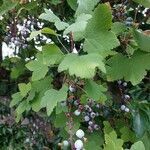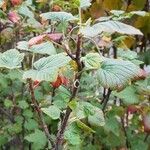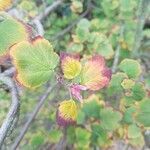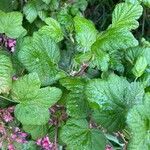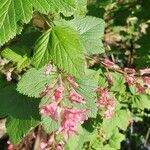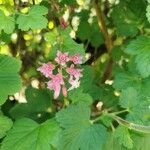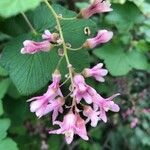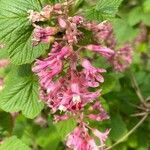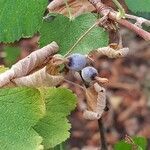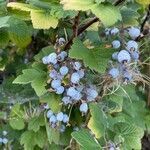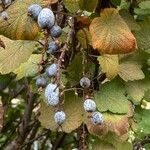Plants 1-4 m. Stems erect, finely pubescent, stipitate-glandular; spines at nodes absent; prickles on internodes absent. Leaves: petiole 2-7 cm, puberulent, short stipitate-glandular; blade broadly reniform or cordate-orbiculate to deltate-ovate, nearly equally to irregularly 5-lobed, cleft nearly 1/4 to midrib, 2-7 cm, base subtruncate to cordate, surfaces puberulent to whitish-tomentose abaxially, puberulent adaxially or puberulent and colorless, sessile-glandular on both surfaces, lobes deltate to obtuse, margins finely 2-3 times crenate and denticulate or serrate, apex broadly acute. Inflorescences pendent to stiffly spreading or ascending or erect, 5-40-flowered racemes, 5-15 cm, axis crisped-pubescent and stipitate-glandular, flowers evenly spaced. Pedicels jointed, 5-10 mm, pubescent, stipitate-glandular; bracts oblanceolate or lanceolate, 2-12 mm, with scattered, short hairs and stalked glands. Flowers: hypanthium white, pink, rose, or red, tubular to campanulate, 3-7 mm, pubescent, stipitate-glandular; sepals not overlapping, spreading or reflexed, white, pink, or red, ovate-elliptic or oblong to oblanceolate or lanceolate, 4-5 mm; petals not or nearly connivent to connivent, erect, white or pink to red, obovate-spatulate to oblong or almost square, not conspicuously revolute or inrolled, 1-3.5 mm; nectary disc not prominent; stamens shorter than to as long as petals; filaments linear or slightly expanded at base, 1.2-2 mm, glabrous; anthers cream, oblong-oval, 0.5-0.8 mm, apex shallowly notched; ovary stipitate-glandular to strongly stipitate-glandular and crisped-puberulent; styles connate nearly to stigmas, 4-6 mm, glabrous or with scattered, stipitate glands at base. Berries palatable but insipid, blue-black, glaucous, ovoid or globose, 3-9(-10) mm, yellowish or greenish stipitate-glandular. 2n = 16.
More
Unarmed, deciduous, moderately aromatic shrub, 1-2-(3) m high; branches and shoots erect, tomentulose or glandular hairy when young. Lvs plicately folded in bud, with petioles to c. 8 cm long, slightly clasping at base; lamina very broadly ovate or deltoid, (3)-4-8-(10) × (3.5)-4-9-(10) cm, often smaller on upper part of flowering stems, deeply palmately-lobed, with 3-5 broadly ovate, coarsely serrate lobes, glabrate or hairy, dull, somewhat rugose with impressed veins above, glabrate to hairy or sometimes tomentose below, sparsely to densely covered with almost colourless, inconspicuous glandular scales; base subcordate to deeply cordate. Racemes pendent, usually 15-many-flowered; fls not fragrant. Hypanthium 4-7 mm long, cylindric, pale pink to deep red, with scattered simple eglandular or glandular hairs. Sepals 4-6.5 mm long, ± elliptic-oblong, pale pink to deep red, glabrous or with simple or glandular hairs, reflexed at anthesis. Petals 3-5 mm long, spathulate or obovate, white ageing pink to rose. Filaments 1-2.5 mm long. Fr. 5-7 mm diam., globose, black, opaque and usually with a whitish bloom, ± glandular; flesh with little taste.
A deciduous shrub. It grows 2-3 m high and 2-3 m wide. The branches are red-brown. The leaves are dark green and have 3-5 lobes. They are downy underneath. The flowers are pink or bright red and occur in sprays. These hang down. The fruit are small and black. They have a white covering over them.
